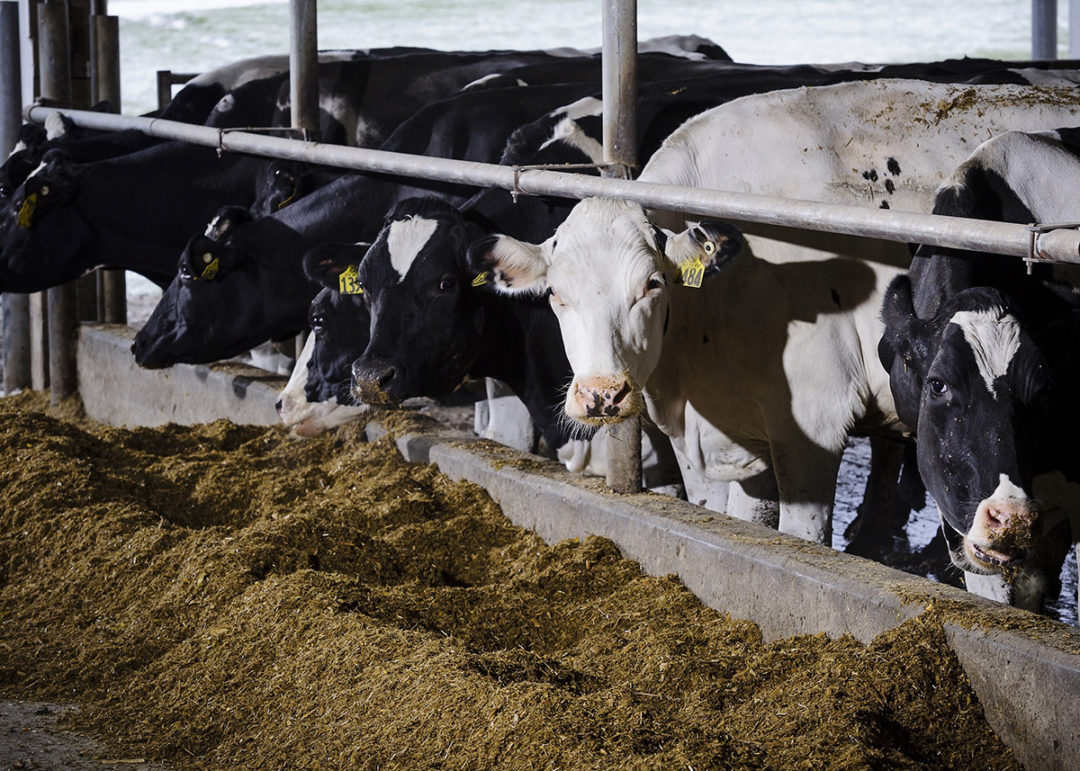Milk urea nitrogen or MUN is a way to see if a dairy farm’s feeding program is a success. A MUN screening test can be performed on a milk sample collected from a cow. It is correlated to the urinary excretion of nitrogen. Normal MUN levels for Holsteins are 10-14 mg/dl, but high protein breeds like Jersey and Swiss tend to be 1.5-2.0 higher. After a cow consumes protein, some of it is degraded to ammonia in the rumen. The portion of this ammonia that cannot be converted to microbial protein by rumen microbes will be converted to urea absorbed into the blood and eventually excreted in the urine. Higher blood urea nitrogen (BUN) and urinary nitrogen are mirrored by higher MUN and that means protein being fed is wasted when MUN levels are elevated. When MUN levels are low, microbial protein will be reduced limiting milk and protein yields.
MUN levels between 10 and 14 are the desired normal range. Once this level is determined for the herd or group that is being evaluated, focus next on the range of values within the herd. Expectations are for ranges to be plus or minus 6 from the average. Results outside this range suggest abnormal function of individuals. When more than 10% of the cows in the herd exceed this range, there may be feed management issues such as feed separation or differences in feed access.
In simplified terms, this means that MUN values that are higher than the recommended range indicate that cows have too much protein in their diet, there’s an imbalance between the protein and energy, and cows are not using their feed as effectively as possible. On the flip side, if MUN values are below the recommended range, that could suggest cows aren’t getting enough protein in their diet or cows could be sacrificing milk production. Both ranges of this scale are not a good place to be for a dairy farm.
Using a milk sample collected either by an employee or certified technician, dairies can send it to a laboratory for MUN testing. When selecting a laboratory be sure to look at their certifications to ensure that they follow industry standards. In addition, consider the other tests that might be beneficial to milk production goals. Perhaps the premium offered by a milk or dairy cooperative requires a milk component report. Maybe screening for pregnancy in a timely manner needs to be improved on the farm. There are many tests that can be run on one milk sample, aside from a MUN test.
The results of a MUN test can help a dairy farm improve its feeding program and save money too. Done in conjunction with feed analysis, MUN provides a look at what nutritionists and herd managers may need to adjust in a feeding program. Testing the current feed will reveal what is in it and help with determining if it needs to be swapped or supplemented with something else. While reviewing rations, changing supplements added to feed, or purchasing additional commodities, dairy farms can test out swapping higher-costing feed items for substitutes that may save money.
For dairy farms that are aiming for improved animal welfare goals, MUN testing can also assist with that. First, improved body conditioning is achieved through the adjustments in the feeding program that provide nutrients that cows need to thrive not only for milk production but also for overall body health. As cows eat and retain more nutrients, their body scores increase, which is a good thing for herd management. Secondly, improved overall health feeds positive reproductive performance. Much like humans, cows need a healthy body to continue to reproduce, and once again, changes to their diet will have an impact on it. MUN testing can be the kickoff point for where a dairy can start to improve breeding program success. As a final point, MUN testing is not an obvious topic of conversation when it comes to animal welfare discussions, however, mentioning it to consumers can be the catalyst for showing how different parts of the farm are connected and feed into a dairy’s goal of keeping their cows healthy, safe and productive.
Many milk laboratories offer MUN testing to farms located across the United States. For those located in the Northeast, Dairy One not only offers this service, but many others mentioned in this article. From milk sample analysis for milk components, pregnancy, and MUN to forage sample testing, Dairy One’s team of professionals is there to help dairies succeed in their goals. Additionally, there are also Dairy Herd Information (DHI) Field Technicians who can visit a farm once a month to collect milk samples during milking.
MUN testing is a valuable test for dairy farms. While at its core, it is a test to see the effectiveness of a feeding program, it branches off into many avenues worth the investment. From saving on feed costs to improving animal welfare goals, it is something that many dairies should consider implementing for their herd health.
For more information, contact Dairy One at [email protected] to receive assistance with testing for MUN levels in your herd.
Written by Dairy One





